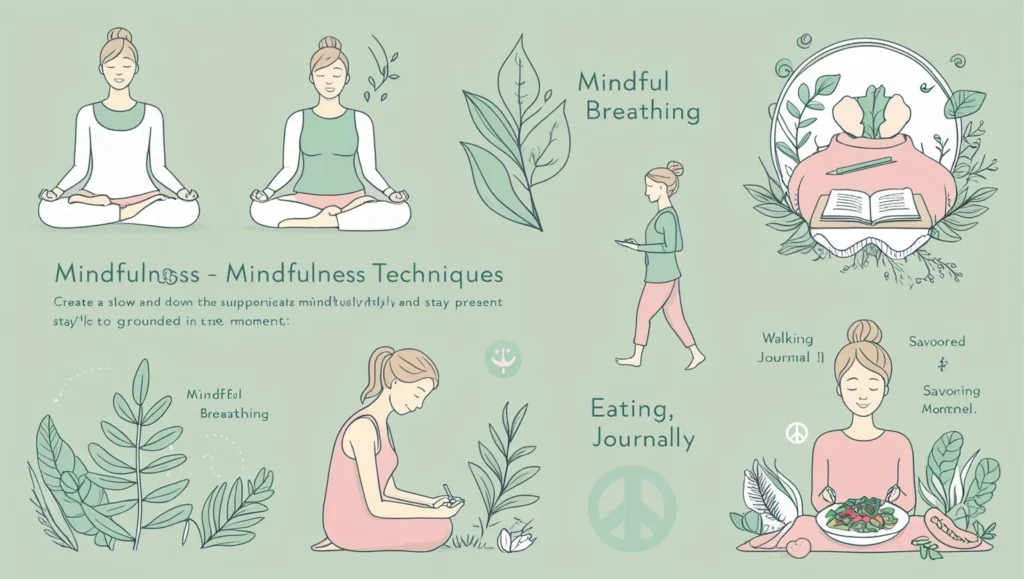Mindfulness Techniques for Everyday Life
In today’s fast-paced world, it’s easy to get caught up in the hustle and bustle, leaving little room for reflection and inner peace. Mindfulness Techniques for Everyday Life However, practicing mindfulness can help you slow down, become more present, and improve your overall well-being. Mindfulness is the art of focusing on the present moment without judgment, allowing you to experience life more fully.
This blog will guide you through several practical mindfulness techniques that you can easily incorporate into your daily routine to reduce stress, increase focus, and foster a sense of calm in your everyday life.
🌿 What is Mindfulness?
Mindfulness is the practice of being fully present in the moment. It involves paying attention to what’s happening around you and within you, without getting distracted by past regrets or future anxieties. Mindfulness Techniques for Everyday Life Rather than rushing through your tasks or constantly thinking about the next thing, mindfulness encourages you to focus on what you’re doing right now.
It has been shown to reduce stress, improve emotional regulation, increase self-awareness, and promote a sense of peace and happiness. The best part? You don’t need to set aside hours of your day to practice mindfulness. There are plenty of simple techniques that you can use at any time.
🌸 1. Mindful Breathing: The Foundation of Mindfulness
Breathing is the simplest way to connect with the present moment, and it’s a technique you can use anytime, anywhere.
How to Practice Mindful Breathing:
- Find a quiet space or even just sit in a chair, and close your eyes.
- Take a deep breath in through your nose, slowly filling your lungs. Hold for a few seconds.
- Exhale slowly through your mouth, focusing on the sensation of your breath leaving your body.
- Focus on the rhythm of your breathing. Notice the coolness of the air as you breathe in and the warmth as you breathe out.
- If your mind starts to wander, gently guide your attention back to your breath without judgment.
Start with a few minutes of mindful breathing each day, and gradually increase the time. This simple exercise helps you center yourself and can be particularly useful in moments of stress or overwhelm.
🌻 2. Mindful Eating: Savor Every Bite
We often eat in a rush, distracted by work, TV, or phones. Mindful eating allows you to reconnect with the food you’re eating and appreciate the textures, flavors, and smells.
How to Practice Mindful Eating:
- Sit down without distractions (turn off your phone, TV, or computer).
- Look at your food. Notice its colors, shapes, and textures.
- Take a small bite and chew slowly, focusing on the taste and texture.
- Pause between bites and savor the flavors. Notice how the food makes you feel.
- Listen to your body to understand when you’re satisfied, rather than eating until you’re full.
Mindful eating helps you enjoy your meals more and also helps with digestion and portion control. It’s a great way to incorporate mindfulness into your daily routine.
🌼 3. Body Scan: Tune Into Your Body
The body scan is a technique where you bring awareness to different parts of your body, noticing any tension, discomfort, or relaxation. Mindfulness Techniques for Everyday Life This practice helps you become more in tune with how you feel physically and emotionally.
How to Practice a Body Scan:
- Lie down or sit comfortably. Close your eyes and take a few deep breaths to relax.
- Start with your toes. Notice any sensations in your toes, then slowly move up through your body, focusing on your feet, legs, abdomen, chest, arms, and head.
- Pay attention to any areas of tension or discomfort. Don’t try to change anything—just notice it.
- Relax your muscles as you focus on each body part, breathing into any areas of tightness or discomfort.
- End at the top of your head and take a few deep breaths, feeling the sense of relaxation throughout your body.
The body scan can help reduce physical tension and is an excellent technique for promoting relaxation and self-awareness.
🌟 4. Mindful Walking: Bringing Presence into Movement
If sitting still doesn’t feel right for you, try mindful walking. This technique combines physical movement with the present-moment awareness you practice in mindfulness.
How to Practice Mindful Walking:
- Find a quiet place to walk, whether indoors or outside.
- Walk slowly and with purpose, focusing on the sensation of your feet touching the ground.
- Notice the movement of your body. Pay attention to how your legs move, the way your arms swing, and your posture.
- Engage all your senses by noticing the sights, sounds, and smells around you.
- If your mind starts to wander, gently bring your focus back to your walking and breath.
Mindful walking can be a great way to clear your mind, reduce stress, and connect with your environment.
🌱 5. Mindful Listening: Fully Engage in Conversations
In today’s world, it’s easy to be distracted while talking to someone, especially with constant notifications and multitasking. Mindful listening means giving the person in front of you your full attention.
How to Practice Mindful Listening:
- Be present. Put away your phone or any distractions before engaging in a conversation.
- Listen actively. Focus on the speaker’s words, tone of voice, and body language.
- Don’t interrupt. Allow the person to finish speaking before responding.
- Notice your thoughts. If your mind starts to wander, gently bring your focus back to the conversation.
- Reflect. After the conversation, take a moment to reflect on what was said and how you felt during the interaction.
Mindful listening fosters deeper connections and helps improve communication.
🍃 6. Mindful Journaling: Reflect on Your Thoughts
Journaling is a powerful way to clear your mind and reflect on your thoughts and emotions. When done mindfully, it can help you process and make sense of your experiences.
How to Practice Mindful Journaling:
- Set aside quiet time each day to journal.
- Write freely without judgment. Don’t worry about grammar or spelling—just let your thoughts flow.
- Reflect on your feelings from the day or week. What has been on your mind? How do you feel right now?
- Practice gratitude by writing down things you’re thankful for, even the small things.
- Close your journal with a few moments of deep breathing or a simple affirmation.
Mindful journaling helps you slow down, process your emotions, and stay grounded.
Final Thoughts
Mindfulness doesn’t require a special space, a lot of time, or an elaborate practice. You can bring mindfulness into your life through simple techniques like mindful breathing, eating, or listening. Mindfulness Techniques for Everyday Life The key is consistency—by incorporating mindfulness into your daily routine, you can reduce stress, increase focus, and cultivate a deeper connection with yourself and the world around you.
Start small by choosing one technique that resonates with you, and gradually build up your practice. Mindfulness Techniques for Everyday Life The more you embrace mindfulness, the more you’ll notice its positive effects in your life.
Remember, mindfulness is about progress, not perfection. Be kind to yourself as you develop your practice, and enjoy the journey of being present.
Happy lettering!

